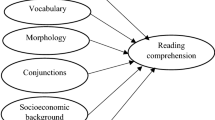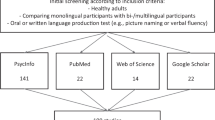Abstract
The majority of studies examining the language and literacy skills of second generation immigrant bilingual children have focused on the breadth of lexical knowledge in populations with a low level of involvement in literacy activities. This study extends previous work in three ways. First, we focused on a sample of second generation immigrant bilingual children from favorable socio-cultural backgrounds. Second, we examined whether these children show lexical knowledge gaps in their second language on various measures of breadth and depth, as compared to their monolingual peers. Finally, we asked whether this gap tends to increase, remain stable, or decrease with formal schooling. Bilingual (n = 70) and monolingual (n = 55) children between the ages of 7 and 8 years were evaluated on measures of depth and breadth of lexical knowledge in the second language of the bilingual group. Both groups were tested twice: at the beginning of second grade and at the beginning of third grade. The findings indicate a significant gap between the target groups with respect to most measures of both depth and breadth at the beginning of second grade. However, after a year of schooling, the bilingual children showed significant progress in their lexical knowledge in their second language. The discussion addresses theoretical and clinical implications of these findings.
Similar content being viewed by others
References
Anglin, J. M. (1985). The child’s expressible knowledge of word concepts. In K. E. Nelson (Ed.), Children’s language (Vol. 5, pp. 77–127). Hillsdale, NJ: Elbaum.
Anglin, J. M. (1993). Vocabulary development: A morphological analysis. Monographs of the Society for Research in Child Development, 58(10), 1–166.
Aram, D., & Biron, S. (2004). Joint storybook reading and joint writing interventions among low SES preschoolers: Differential contributions to early literacy. Early Childhood Research Quarterly, 19(4), 588–610.
August, D., Carlo, M., Dressler, C., & Snow, C. (2005). The critical role of vocabulary development for English language learners. Learning Disabilities Research and Practice, 20(1), 50–57.
August, D., & Shanahan, T. (Eds.). (2006). Developing literacy in second-language learners: A report of the national literacy panel on language-minority children and youth. Mahwah, NJ: Lawrence Erlbaum Associates, Inc.
Ben-Rafael, E., Lyubansky, M., Glöckner, O., Harris, P., Israel, Y., Jasper, W., et al. (2006). Building a Diaspora: Russian Jews in Israel, Germany and the USA. Leiden, The Netherlands: Brill.
Bialystok, E. (2009). The good, the bad, and the indifferent. Bilingualism: Language and Cognition, 12(1), 3–11.
Chen, Y. (2007). Contributing to success: Chinese parents and the community school. In J. Conteh, P. Martin, & L. H. Robertson (Eds.), Multilingual learning: Stories from schools and communities in Britain. Stoke-on-Trent, England: Trentham.
Cobo-Lewis, A. B., Pearson, B. Z., Eilers, R. E., & Umbel, V. C. (2002). Effects of bilingualism and bilingual education on oral and written Spanish skills: A multifactor study of standardized test outcomes. In D. K. Oller & R. E. Eilers (Eds.), Language and literacy in bilingual children (pp. 98–117). Clevedon, UK: Multilingual Matters.
Cohen, J. (1992). A power primer. Psychological Bulletin, 112, 155–159.
Cruse, D. A. (1986). Lexical semantics. Cambridge, England, UK: University Press.
Droop, M., & Verhoeven, L. (1998). Background knowledge, linguistic complexity, and second-language reading comprehension. Journal of Literacy Research, 30(2), 253–271.
Dunn, L. M. (1965). Peabody picture vocabulary test. Minnesota, US: American Guidance Service.
Francis, H. (1972). Toward an explanation of the syntagmatic-paradigmatic shift. Child Development, 43(3), 949–958.
García, G. E. (2000). Bilingual children’s reading. In M. L. Kamil, P. B. Mosenthal, P. D. Pearson, & R. Barr (Eds.), Handbook of reading research (Vol. 3, pp. 813–834). Mahwah, NJ: Erlbaum.
Goldberg, H., Paradis, J., & Crago, M. (2008). Lexical acquisition over time in minority first language children learning English as a second language. Applied Psycholinguistics, 29, 1–25.
Gough, P. B., & Tunmer, W. E. (1986). Decoding, reading, and reading disability. Remedial and Special Education, 7, 6–10.
Grinboim, N., & Likhter, I. (1996). Reading and writing test. Kiryat Tiv’on, Israel: Oranim [in Hebrew].
Horowitz, T. (1986). The absorption of the Soviet Jews in Israel, 1969–1984: Integration without acculturation. In T. Horowitz (Ed.), Between two words: Children from the Soviet Union in Israel (pp. 33–49). Lanham, MD: University Press of America.
Jakobson, R. (1971). Selected writings (Vol. 3). The Hague, Netherlands: Mouton.
Katzir, T., Lesaux, N., & Kim, Y. (2009). The role of reading self-concept and home literacy practices in fourth grade reading comprehension. Reading and Writing: An Interdisciplinary Journal, 22(3), 261–276.
Kuczaj, S. A. (1999). The development of language. In M. Barrett (Ed.), The world of words: Thoughts on the development of a lexicon (pp. 134–155). UK: University of Surrey.
Lesaux, N. K., & Geva, E. (2006). Synthesis: Development of literacy in language-minority students. In D. L. August & T. Shanahan (Eds.), Developing literacy in a second language: Report of the national literacy panel (pp. 53–74). Mahwah, NJ: Lawrence Erlbaum Associates.
Lesaux, N. K., Koda, K., Siegel, L. S., & Shanahan, T. (2006). Development of literacy. In D. L. August & T. Shanahan (Eds.), Developing literacy in a second language: Report of the national literacy panel (pp. 75–122). Mahwah, NJ: Lawrence Erlbaum Associates.
Leshem, E., & Lissak, M. (1999). Development and consolidation of the Russian community in Israel. In S. Weil (Ed.), Roots and routes: Ethnicity and migration in global perspective (pp. 135–171). Hebrew University, Jerusalem, Israel: The Magnes Press.
Louie, V. S. (2004). Compelled to excel: Immigration, education, and opportunity among Chinese Americans. Stanford, US: Stanford University Press.
Lyons, J. (1968). Introduction to theoretical linguistics. Cambridge, England, UK: University Press.
Meisel, J. M. (2008, July–August). Morphological development in early child second language acquisition. Paper presented at the 11th congress of the international association for the study of child language, Edinburgh, UK.
Ministry of Education. (2003). New program of language education. Retrieved from http://cms.education.gov.il/EducationCMS/Units/TohnijotLimud [in Hebrew].
Nagy, W. E. (1988). Teaching vocabulary to improve reading comprehension. Newark, DE: International Reading Association.
Nagy, W. E., & Scott, J. A. (2000). Vocabulary processes. In M. L. Kamil, P. Mosenthal, P. D. Pearson, & R. Barr (Eds.), Handbook of reading research (Vol. 3, pp. 269–284). Mahwah, NJ: Earlbaum.
Nevo, B. (1979). Peabody picture vocabulary test—Hebrew version. Haifa, Israel: University of Haifa. (Original work published 1965).
Oller, D. K. (2005). The distributed characteristic in bilingual learning. In J. Cohen, K. T. McAlister, K. Rolstad, & J. MacSwan (Eds.), Proceedings of the 4th international symposium on bilingualism (pp. 1744–1749). Somerville, MA: Cascadilla Press.
Oller, D. K., & Pearson, B. Z. (2002). The effects of bilingualism: A background. In D. K. Oller & R. E. Eilers (Eds.), Language and literacy in bilingual children (pp. 3–22). Clevedon, UK: Multilingual Matters.
Olshtain, E., & Kotik, B. (2000). The development of bilingualism in an immigrant community. In E. Olshtein & G. Hornczyk (Eds.), Language, identity, and immigration (pp. 210–217). Hebrew University, Jerusalem, Israel: The Magnes Press.
Ordóñez, C. L., Carlo, M. S., Snow, C. E., & McLaughlin, B. (2002). Depth and breadth of vocabulary in two languages: Which vocabulary skills transfer? Journal of Educational Psychology, 94(4), 719–728.
Pearson, B. Z., & Fernández, S. (1994). Patterns of interaction in the lexical growth in two languages of bilingual infants and toddlers. Language learning, 44, 617–653.
Perfetti, C. A., & Hart, L. (2002). The lexical quality hypothesis. In L. Verhoeven, C. Elbro, & P. Reitsma (Eds.), Precursors of functional literacy (pp. 189–213). Amsterdam, Netherlands: John Benjamins.
Portes, A., & Rumbaut, R. G. (2001). Legacies: The story of the immigrant second generation. Berkeley, CA: University of California Press.
Raven, J., Raven, J. C., & Court, J. H. (1998). Raven manual: Section 3. Standard progressive matrices. Oxford, England, UK: Oxford Psychologists Press.
Richard, G. I., & Hanner, M. A. (1985). Language processing test. Moline, II: Linguisystems.
Rom, A., & Moreg, L. (1999). Assessment of oral language processing. Tel-Aviv, Israel: Kibbutzim College of Education. [In Hebrew].
Saracho, O. N. (1997). Using the home environment to support emergent literacy. Early Child Development and Care, 127(1), 201–216.
Schaufeli, A. (1992). A domain approach to the Turkish vocabulary of bilingual Turkish children in the Netherlands. In W. Fase, K. Jaspaert, & S. Kroon (Eds.), Maintenance and loss of minority languages (pp. 117–135). Amsterdam, Netherlands: John Benjamins.
Schwartz, M. (2006). The impact of literacy acquisition in L1 Russian on literacy acquisition in L2 Hebrew and in L3 English among Russian-speaking (L1) children: Bi-literate bilingualism versus mono-literate bilingualism. Unpublished doctoral dissertation, University of Haifa, Haifa, Israel [in Hebrew].
Schwartz, M., Kozminsky, E., & Leikin, M. (2006). Language tests. Unpublished tests, Ben-Gurion University, Beer-Sheva, Israel.
Schwartz, M., Kozminsky, E., & Leikin, M. (2009). Towards a better understanding of the first language vocabulary knowledge: The case of second generation Russian-Jewish immigrants in Israel. Diaspora, Indigenous, and Minority Education: An International Journal, 3, 226–244.
Sénéchal, M., LeFevre, J., Hudson, E., & Lawson, E. P. (1996). Knowledge of storybooks as a predictor of young children’s vocabulary. Journal of Educational Psychology, 88, 520–536.
Share, D. L., & Levin, I. (1999). Learning to read and write in Hebrew. In M. Harris & G. Hatano (Eds.), Learning to read and write: A cross-linguistic perspective (pp. 89–111). Cambridge, England, UK: Cambridge University Press.
Sheng, L., McGregor, K. K., & Marian, V. (2006). Lexical-semantic organization in bilingual children: Evidence from a repeated word association task. Journal of Speech. Language and Hearing Research, 49(3), 572–587.
Snow, C. E. (1990). The development of definition skill. Journal of Child Language, 17, 697–710.
Spolsky, B. (2007). Family language management: Some preliminaries. In A. Stavans & I. Kupferberg (Eds.), Studies in language and language education: Essays in honor of Elite Olshtain (pp. 429–449). Hebrew University, Jerusalem, Israel: The Magnes Press.
Stoep, J., & Verhoeven, L. (2001). Family and classroom predictors of children’s early language and literacy development. In T. Shanahan & F. V. Rodriguez-Brown (Eds.), National reading conference yearbook: Yearbook 49 (pp. 209–221). Chicago, US: National Reading Conference.
Verhallen, M., & Schoonen, R. (1993). Lexical knowledge of monolingual and bilingual children. Applied Linguistics, 14(4), 344–363.
Verhallen, M., & Schoonen, R. (1998). Lexical knowledge in L1 and L2 third and fifth graders. Applied Linguistics, 19(4), 452–470.
Verhoeven, L. (2007). Early bilingualism, language transfer, and phonological awareness. Applied Psycholinguistics, 28(3), 425–439.
Vermeer, A. (2001). Coming to grips with lexical richness in spontaneous speech data. Language Testing, 17(1), 65–83.
Wesche, M., & Paribakht, T. M. (1996). Assessing vocabulary knowledge: Depth versus breadth. Canadian Modern Language Review, 53, 13–40.
Wolf, M. (2007). Proust and the squid: The story and science of the reading brain. New York, NY: Harper Collins.
Author information
Authors and Affiliations
Corresponding author
Rights and permissions
About this article
Cite this article
Schwartz, M., Katzir, T. Depth of lexical knowledge among bilingual children: the impact of schooling. Read Writ 25, 1947–1971 (2012). https://doi.org/10.1007/s11145-011-9308-9
Published:
Issue Date:
DOI: https://doi.org/10.1007/s11145-011-9308-9




